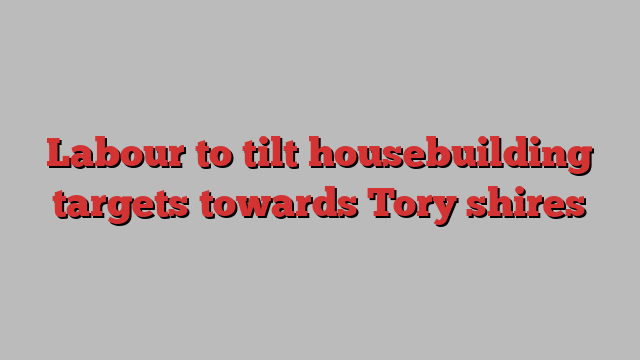
Unlock the Editor’s Digest for free
Roula Khalaf, Editor of the FT, selects her favourite stories in this weekly newsletter.
Ministers will tilt housebuilding targets away from Labour-supporting big cities towards more rural Tory heartlands and stop councils from blocking developments because they are “out of character” with their surroundings.
The package of measures from the new Labour government will mean that London’s target, which has long been seen as unrealistically high by the housebuilding industry, will end up lower than under the Conservatives.
The measures unveiled by the UK government on Tuesday are part of a package of planning reforms pushed by Labour to ramp up the supply of new housing to 300,000 a year, a figure not seen for half a century.
The changes to national planning guidelines include the reintroduction of mandatory housing targets on local authorities in England. The targets had been made advisory by the former Conservative government.
Ministers will also rework the formula under which those targets are set so that the biggest 20 urban areas in England no longer have targets 35 per cent higher than elsewhere.
That urban “uplift” was devised by Tory ministers to pacify their mutinous backbenchers, who wanted more homes built in urban Labour areas rather than their own more leafy constituencies. The measure was deeply resented by affected local authorities.
Instead all areas will be ordered to lift housing supply by 0.8 per cent annually, tweaked according to affordability criteria to force more building in expensive areas, such as London and the south-east.
Previously the target in London was 100,000 a year. Government officials said it would now fall to 80,000.
The government said it was introducing a “universal system of strategic planning” across England.
Councils will be warned that ministers will take over their plans for housing in their areas if they have not been kept up-to-date. Currently only a third of councils have a plan that is under five years old.
The government will consult on removing certain references to “beauty” in the NPPF on the basis that it was a subjective criteria for judging new developments that could be used by councils to arbitrarily block some schemes.
Local authorities would also be stripped from their ability to resist developments on the basis that they are “out of character” under the proposals.
The government insisted that brownfield land would still be the “first port of call for development” with scope for greater densities of housing in urban areas.
Yet councils will be urged to identify “grey belt” land within green belt areas, such as old car parks or scrubland, where some limited building can take place so long as it meets “golden rules”.
The “grey belt” rules would require such development to deliver 50 per cent affordable housing, increased access to green spaces and new infrastructure such as schools and GP surgeries.
Last year 231,100 new homes were built in the UK. Officials said total supply projections for coming years have fallen to below 200,000, far below their future target of 300,000.
Chancellor Rachel Reeves is expected to lift government funding for social housing at the spending review in the autumn. She would also use her first Budget on October 30 to give councils and housing associations “rent stability”, the government said. This will involve guaranteeing how much they can increase rent each year to give them certainty to borrow and invest in more homes.
Last week the government set out a planning and infrastructure bill in the King’s Speech that will overhaul the way in which compulsory purchase orders work. The bill will also introduce a national scheme of delegation that “focuses planning committees on the applications that really matter” and avoid potential developments being reviewed multiple times.
The government intends to slash the discounts available to residents of council houses who wish to buy their home under “right to buy” rules introduced by the Conservatives in the 1980s. The changes are set to take place this autumn. Councils will also be given greater flexibility to use receipts from those homes to build and buy more social housing.
The government also intends to hold a wider consultation on how the right to buy system works.
Meanwhile fees paid on applications for alterations or extensions to a home will rise from £258 to £528, subject to a consultation later this year.
The hike is likely to be a prelude to councils being able to set their own planning fees for bigger developments, which could raise more money to fund depleted planning departments.

